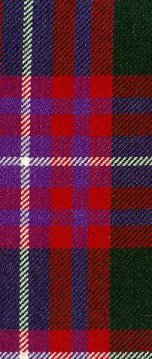
Utah Symbols
- State Resources
- » 50 States
- » Utah
- » Symbols
Utah State Centennial Tartan
Tartan
Adopted on February 28, 1996
The Utah Centennial Tartan was adopted on February 28, 1996.
During the 1996 Utah Legislative session, SB-13 was suggested by Garry Bryant, KdeB, KCR, SC, and the tartan designed by Dr. Philip D. Smith, Jr., FSA Scot, FSTS, of Narvon, PA., with the bill sponsored by Senator LeRay McAllister of Orem. Governor Michael Leavitt signed it into law on February 28th. Utah Code
The Utah Centennial Tartan shall have a pattern or repeating-half-sett of white-2, blue-6, red-6, blue-4, red-6, green-18, red-6, and white-4 to represent the tartan worn anciently by the Logan and Skene clans, with the addition of a white stripe. The tartan honors the first Scots known to have been in Utah and those Utahns of Scottish heritage. The Lieutenant Governor shall register the tartan with the United States branch of the Scottish Tartans Authority in Skippack, Pennsylvania, 19474.
Utah State Centennial Tartan: Tartan
*The first American of Scottish descent who left a permanent mark upon Utah was Ephraim Logan. Logan was a mountain man who visited Cache Valley in northern Utah, and named the river that ran through the valley after his ancestral Scottish clan in 1824. When the settlers came to Cache Valley the settlement was called after the Logan River. A year after Logan's visit, Hudson Bay Company Cmdr., (out of Fort Vancouver, Oregon) Peter Skene Ogden, a fur trapper, and great explorer of the West, came to a place he called New Valley. He had in his company 70 trappers with wives and children. Ogden wrote, "I only wish we could find a dozen spots equal to it (later called Ogden)." Also in 1824, came another Scott explorer, Charles MacKay, also of the mountain-man genre. He recorded in his journal, of standing on a mountain and seeing the Great Salt Lake.
The Logan tartan was one of the original 19 tartans of Scotland in 1819, recorded in the weave book of Wilson & Son of Bannockburn. The Logans discarded the sett in the 1830s and was adopted by the Skenes in the 1850s until they discarded it during the 1880s. Utah's tartan resurrected this sett of Red, Green and Blue, and added a white strip for differening. It is very symbolic.
*From Utah Scottish Assoc. 1996 Scottish Festival booklet.
Utah Code
Title 63G General Government
Chapter 1 State Symbols and Designations
Section 601 State symbols.
63G-1-601. State symbols.
(5) Utah's state centennial tartan, which honors the first Scots known to have been in Utah and those Utahns of Scottish heritage, shall have a pattern or repeating-half-sett of white-2, blue-6, red-6, blue-4, red-6, green-18, red-6, and white-4 to represent the tartan worn anciently by the Logan and Skene clans, with the addition of a white stripe.
Amended by Chapter 46, 2014 G
63-13-5.5. State symbols.
(5) Utah's state centennial tartan, which honors the first Scots known to have been in Utah and those Utahns of Scottish heritage, shall have a pattern or repeating-half-sett of white-2, blue-6, red-6, blue-4, red-6, green-18, red-6, and white-4 to represent the tartan worn anciently by the Logan and Skene clans, with the addition of a white stripe.
Amended by Chapter 46, 2014 General Session







